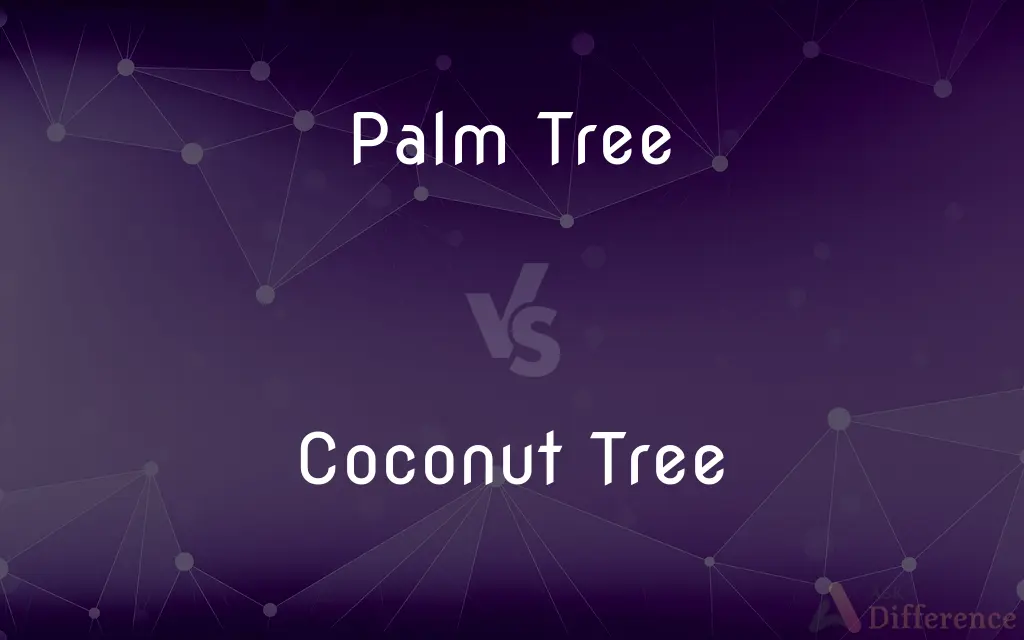Palm Tree vs. Coconut Tree — What's the Difference?
By Maham Liaqat & Fiza Rafique — Published on March 4, 2024
Palm trees are a diverse family of plants with over 2,600 species, including the coconut tree, which is a type of palm known for its large nuts used for their water, milk, and meat.

Difference Between Palm Tree and Coconut Tree
Table of Contents
ADVERTISEMENT
Key Differences
Palm trees represent a wide variety of species within the Arecaceae family, characterized by their large, evergreen leaves and often tall, unbranched trunks. The coconut tree, specifically Cocos nucifera, stands out as a distinct species within this family, prized for its versatile fruit.
Palm trees can vary greatly in size, habitat, and appearance, ranging from small, bushy plants to towering individuals, whereas coconut trees are known for their uniform tall stature, with a crown of large, feather-like leaves and a slender trunk. This makes the coconut tree easily recognizable among other palms.
The habitat of palm trees spans across tropical, subtropical, and warm temperate climates, with some species adapted to desert or mountainous regions. In contrast, coconut trees prefer coastal areas in tropical climates, thriving on sandy soils and requiring plenty of sunlight and regular rainfall to produce their fruit.
The uses of palm trees are as varied as their species, including food, shelter, and materials for tools and crafts. Coconut trees, however, are particularly valued for their coconuts, which provide water, oil, milk, and meat, alongside uses in furniture and construction for their wood and fibers.
In terms of cultivation, many palm trees are grown for ornamental purposes, adapting well to various landscapes. Coconut trees, while also ornamental, are extensively cultivated for their economic value, with their cultivation practices focusing on maximizing fruit production.
ADVERTISEMENT
Comparison Chart
Species Variety
Over 2,600 species
One primary species (Cocos nucifera)
Appearance
Varies widely from bushy to tall and slender
Tall, with a slender trunk and large, feather-like leaves
Habitat
Tropical, subtropical, warm temperate, deserts, mountains
Predominantly tropical coastal areas
Uses
Food, shelter, materials for crafts, ornamental
Coconuts (water, oil, milk, meat), wood, fibers, ornamental
Cultivation
Varied, often ornamental
Focused on fruit production, requires specific tropical conditions
Compare with Definitions
Palm Tree
Palms can grow in a variety of climates, including deserts and rainforests.
The Washingtonia robusta thrives in arid conditions, showcasing the adaptability of palm trees.
Coconut Tree
Cultivated primarily for its economic value in producing coconuts.
Coconut plantations are carefully managed to optimize fruit production.
Palm Tree
They vary in size and appearance, from small shrubs to large trees.
The dwarf palmetto fits under the palm tree category but grows low to the ground.
Coconut Tree
It has a tall, slender trunk with a crown of large leaves.
Coconut trees line the beaches, their crowns swaying in the breeze.
Palm Tree
Their products can include fruits, oils, and materials for crafts.
The sago palm is harvested for its edible starch.
Coconut Tree
Predominantly found in tropical coastal areas, requiring sandy soils.
Coconut trees are a common sight on tropical islands, thriving near the ocean.
Palm Tree
Palm trees are a diverse group within the Arecaceae family, used for food, shelter, and more.
The date palm provides a staple food in many cultures.
Coconut Tree
The coconut has various uses, from its water and meat to oil and fibers.
Coconut oil, extracted from the meat, is used in cooking and cosmetics.
Palm Tree
Many palms are cultivated for their ornamental value in landscapes.
The royal palm is planted along boulevards for its majestic appearance.
Coconut Tree
The coconut tree is a type of palm known for its versatile fruit.
Coconut water is a refreshing drink directly from the coconut tree.
Palm Tree
Alternative spelling of palm tree
Common Curiosities
Is the coconut tree considered a palm tree?
Yes, the coconut tree is a type of palm tree within the Arecaceae family.
Do all palm trees grow to the same height?
No, palm trees vary greatly in height, from small, ground-level plants to towering trees over 100 feet tall.
What makes a coconut tree different from other palm trees?
The coconut tree is specifically known for its coconuts, a unique fruit used for water, milk, and oil, distinguishing it from other palms.
What part of the palm tree is used for making furniture?
The wood (trunk) of certain palm trees, including the coconut tree, can be used to make furniture.
Can all palm trees produce coconuts?
No, only the coconut tree (Cocos nucifera) produces coconuts.
What are the primary uses of palm trees besides coconuts?
Palm trees provide dates, oil (from palms like the oil palm), materials for construction and crafts, and are also used as ornamental plants.
Are palm trees only found in tropical climates?
While many palm species thrive in tropical climates, some can also be found in subtropical and warm temperate zones, and even deserts and mountains.
What's the ecological importance of palm trees?
Palm trees provide habitat, food, and resources for a variety of wildlife, playing crucial roles in their ecosystems.
How do you differentiate between different types of palm trees?
Differentiation can be based on leaf shape, size, trunk characteristics, fruit, and habitat preferences.
Why are coconut trees often planted along coastlines?
Coconut trees are salt-tolerant and thrive in sandy soils, making coastlines ideal for their growth; they also help in stabilizing the shoreline.
What are some common diseases that affect palm and coconut trees?
Both can be affected by diseases like lethal yellowing, bud rot, and various fungal infections, impacting their health and productivity.
How long does it take for a coconut tree to start producing fruit?
A coconut tree typically starts producing fruit after 6-10 years of growth.
Can coconut trees grow in non-tropical climates?
Coconut trees require tropical climates with consistent warm temperatures, sunlight, and high humidity, making it challenging to grow them in non-tropical climates.
Are there any palm trees that can survive in cold weather?
Yes, some palm species, like the Trachycarpus fortunei, can tolerate cold weather and even snow.
Can the fibers of coconut trees be used for anything?
Yes, coconut fibers (coir) are used in making ropes, mats, and brushes due to their durability and resistance to water.
Share Your Discovery

Previous Comparison
NFL vs. AFL
Next Comparison
Laminate Flooring vs. Hybrid FlooringAuthor Spotlight
Written by
Maham LiaqatCo-written by
Fiza RafiqueFiza Rafique is a skilled content writer at AskDifference.com, where she meticulously refines and enhances written pieces. Drawing from her vast editorial expertise, Fiza ensures clarity, accuracy, and precision in every article. Passionate about language, she continually seeks to elevate the quality of content for readers worldwide.














































